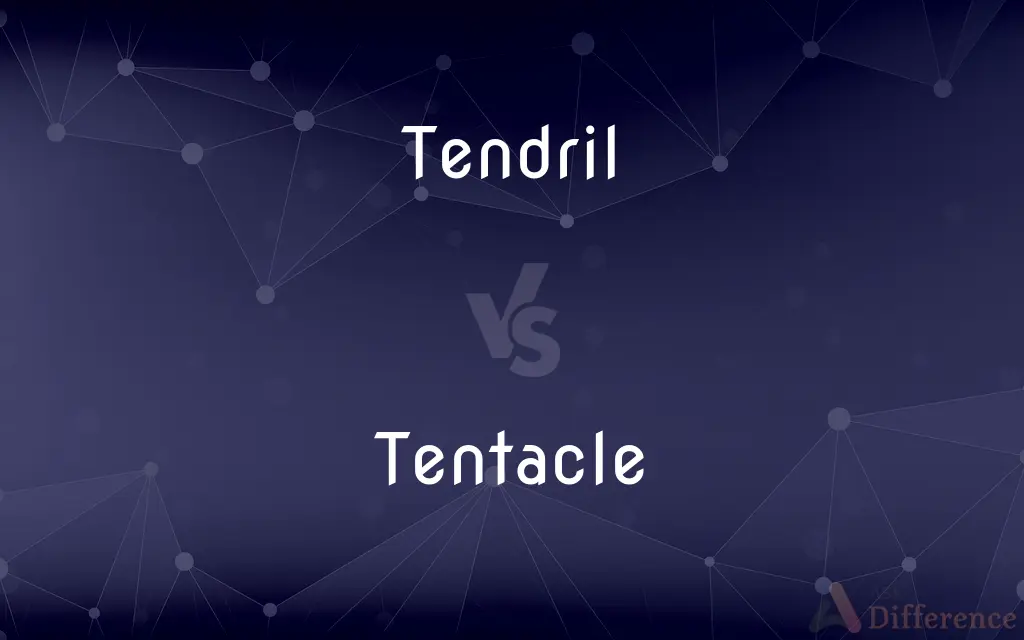Tendril vs. Tentacle — What's the Difference?
By Urooj Arif & Maham Liaqat — Updated on April 2, 2024
A tendril is a slender, twining plant part used for support and attachment, while a tentacle is a flexible, elongated appendage found in animals, often used for feeling or grasping.

Difference Between Tendril and Tentacle
Table of Contents
ADVERTISEMENT
Key Differences
Tendrils are specialized plant organs that grow in a spiral form, enabling plants like vines to cling onto supports and climb towards light sources. Whereas tentacles are found in animals, particularly in marine life such as octopuses and jellyfish, serving various functions including sensation, locomotion, and capturing prey.
The primary function of tendrils is to secure plants to their surroundings, providing stability and support as they grow. On the other hand, tentacles are more versatile, involved in feeding, movement, and sensory activities, showcasing a greater range of functions compared to tendrils.
Tendrils are a response to the plant’s need to maximize light exposure without expending energy on thick stems or trunks for support. Tentacles, however, are adaptations for survival in environments where mobility, food capture, and interaction with the environment are crucial for the organism's success.
Tendrils can be modified leaves, stems, or even parts of leaves, indicating their plant origin and function in support. Tentacles are muscular, often with suction cups or adhesive surfaces, reflecting their role in grasping and manipulating objects or prey.
While tendrils operate through a passive mechanism of coiling around supports triggered by touch, tentacles actively seek out and interact with their environment, demonstrating the dynamic nature of animal adaptations compared to the static growth patterns of plants.
ADVERTISEMENT
Comparison Chart
Definition
A slender, twining plant part used for attachment and support.
A flexible, elongated appendage in animals for feeling or grasping.
Primary Function
Support and attachment for climbing plants.
Sensation, locomotion, and capturing prey.
Found In
Plants, particularly climbing vines and some vegetables.
Animals, especially marine species like octopuses and jellyfish.
Structural Origin
Modified leaves, stems, or parts of leaves.
Muscular appendages, sometimes with suction cups or hooks.
Mechanism of Action
Passive coiling around supports triggered by contact.
Active movement seeking interaction with the environment.
Versatility
Primarily for support and climbing.
Used for a wide range of functions including feeding and movement.
Environmental Adaptation
Maximizes light exposure with minimal energy expenditure on support structures.
Enhances survival through improved mobility, feeding, and sensory capabilities.
Compare with Definitions
Tendril
An adaptation for vertical growth without strong stems.
Tendrils allow cucumbers to climb up a support, maximizing space in the garden.
Tentacle
A flexible limb in marine animals for capturing prey.
Jellyfish tentacles can stun and ensnare small fish.
Tendril
A modification of a plant part for climbing or support.
In some plants, tendrils are modified leaves aimed at reaching sunlight.
Tentacle
A feature in myth and fiction, often exaggerated.
The creature's tentacles waved menacingly above the water, as described in the story.
Tendril
A symbol of delicate strength in plant life.
The tendril's grip on the fence illustrated nature's tenacity.
Tentacle
An appendage in animals for sensation and grasping.
The octopus used its tentacles to explore the ocean floor.
Tendril
A plant organ that supports climbing by coiling around objects.
The pea plant's tendrils wrapped tightly around the trellis.
Tentacle
A part of sensory systems in some animals.
The sea anemone's tentacles detect the presence of prey passing by.
Tendril
A thin, spiral growth used by plants for anchorage.
The grapevine's tendrils secured it to the overhead wires.
Tentacle
Equipped with suction cups or adhesive for holding.
The squid's tentacles have powerful suction cups for gripping.
Tendril
In botany, a tendril is a specialized stem, leaf or petiole with a threadlike shape used by climbing plants for support and attachment, as well as cellular invasion by parasitic plants such as Cuscuta. Tendrils are responsive to touch and to chemical factors by curling, twining, or adhering to suitable structures or hosts.
Tentacle
In zoology, a tentacle is a flexible, mobile, elongated organ present in some species of animals, most of them invertebrates. In animal anatomy, tentacles usually occur in one or more pairs.
Tendril
A slender threadlike appendage of a climbing plant, often growing in a spiral form, that stretches out and twines round any suitable support.
Tentacle
An elongated flexible unsegmented extension, as one of those surrounding the mouth of a sea anemone, used for feeling, grasping, or locomotion.
Tendril
A twisting, slender structure by which a plant, such as a grape or cucumber, twines around and often climbs an object or another plant.
Tentacle
One of these structures in a cephalopod, typically being retractile and having a clublike end usually with suckers or hooks, in contrast to an arm, which is nonretractile and typically has suckers along the underside.
Tendril
Something, such as a ringlet of hair, that is long, slender, and curling.
Tentacle
(Botany) One of the sensitive hairs on the leaves of certain insectivorous plants, such as a sundew.
Tendril
(botany) A thin, spirally coiling stem that attaches a plant to its support.
Tentacle
A similar part or extension, especially with respect to the ability to extend influence, activity, or control
An espionage network with far-reaching tentacles.
Tendril
(zoology) A hair-like tentacle.
Tentacle
(zoology) An elongated, boneless, flexible organ or limb of some animals, such as the octopus and squid.
Tendril
Having the shape or properties of a tendril; thin and coiling; entwining.
Tentacle
(botany) One of the glandular hairs on the leaves of certain insectivorous plants.
Tendril
A slender, leafless portion of a plant by which it becomes attached to a supporting body, after which the tendril usually contracts by coiling spirally.
Tentacle
(figurative) An insidious reach or influence.
The tentacles of the criminal underworld
Tendril
Clasping; climbing as a tendril.
Tentacle
Something like a zoological limb.
Tendril
Slender stemlike structure by which some twining plants attach themselves to an object for support
Tentacle
An officer employed to drive out to troops and transmit back requests for support via a special radio link.
Tentacle
To move like a tentacle
Tentacle
A more or less elongated process or organ, simple or branched, proceeding from the head or cephalic region of invertebrate animals, being either an organ of sense, prehension, or motion.
Tentacle
Something that acts like a tentacle in its ability to grasp;
Caught in the tentacles of organized crime
Tentacle
Any of various elongated tactile or prehensile flexible organs that occur on the head or near the mouth in many animals used for feeling or grasping or locomotion
Common Curiosities
What is the main difference between a tendril and a tentacle?
Tendrils are plant organs for support and climbing, while tentacles are animal appendages for sensation, movement, and capturing prey.
What functions do tentacles serve?
Tentacles are used for sensing the environment, moving, and capturing or manipulating prey.
Are all tendrils the same?
No, tendrils can vary in origin, being modified stems, leaves, or parts of leaves, depending on the plant species.
Can tentacles regenerate if damaged?
In many animals, such as octopuses, tentacles can regenerate after injury, showcasing their adaptability.
Can tendrils and tentacles be found in both plants and animals?
Tendrils are exclusive to plants, particularly climbers. Tentacles are found only in animals, especially in marine species.
How do tendrils work?
Tendrils coil around objects for support, a passive process triggered by touch, allowing plants to climb towards light.
Are tendrils capable of movement?
Tendrils can move in a limited fashion, coiling around supports, but this is a slow, passive process.
How important are tentacles for marine animals?
They're crucial for feeding, defense, and interaction with the environment, aiding in survival.
Can the presence of tendrils or tentacles indicate the habitat of an organism?
Yes, tendrils typically indicate a plant adapted to climbing in dense vegetation, while tentacles suggest an aquatic or marine habitat.
Can tendrils be found on all climbing plants?
Not all climbers have tendrils; some use other structures like hooks or adhesive pads for climbing.
Do tentacles have sensory capabilities?
Yes, many tentacles are equipped with sensory receptors for detecting environmental stimuli and prey.
Are there any plants with structures similar to tentacles?
Some carnivorous plants have appendages that might resemble tentacles, but these are not used for sensation or movement in the same way.
How do tendrils detect where to grow or coil?
Tendrils respond to touch stimuli, growing towards and coiling around nearby objects for support.
How do animals with tentacles use them for movement?
Some animals, like octopuses, use tentacles for propulsion and navigating their environment.
What evolutionary advantage do tendrils provide?
Tendrils allow plants to reach sunlight without investing energy in developing strong, upright stems.
Share Your Discovery

Previous Comparison
Obsolete vs. Old
Next Comparison
Dextrose vs. SugarAuthor Spotlight
Written by
Urooj ArifUrooj is a skilled content writer at Ask Difference, known for her exceptional ability to simplify complex topics into engaging and informative content. With a passion for research and a flair for clear, concise writing, she consistently delivers articles that resonate with our diverse audience.
Co-written by
Maham Liaqat















































